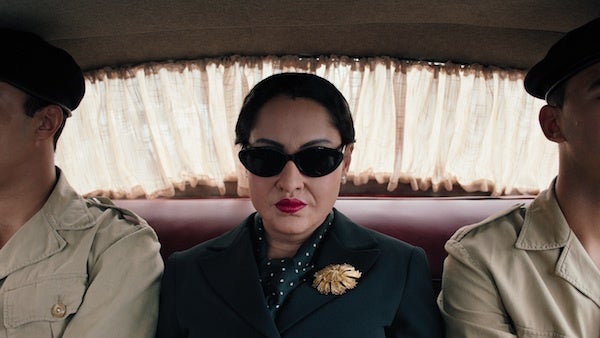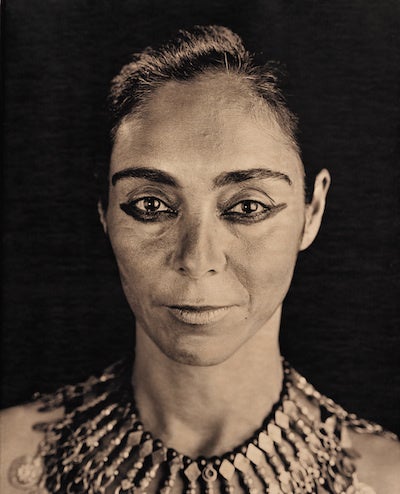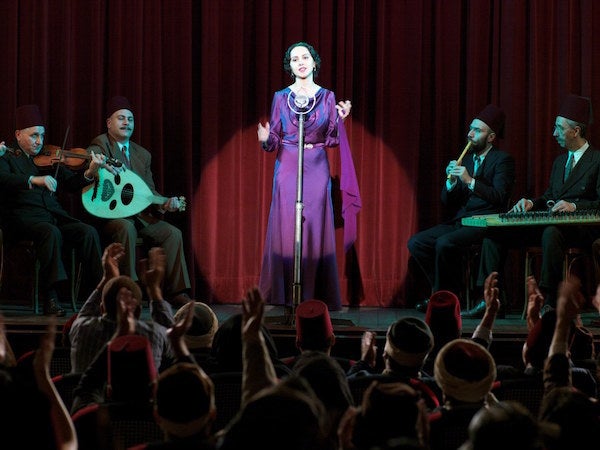
Is the secret to cinema’s success this idea that we can meet within a film someone who is so different from us and yet learn about each other, thus finding out just how close and similar we really are?
Iranian born artist and filmmaker Shirin Neshat may hail from a different side of the globe, her medium may be visual while mine the written word, and her history unrelated to mine and yet when I sat down for our interview about her latest film, we may as well have been sisters. Actually, my connection with the beautiful, fascinating Neshat started a while ago, with her 2009 film ‘Women Without Men’. It continues wholeheartedly with her latest, the quiet masterpiece ‘Looking for Oum Kulthum’.
To anyone who hails from the Arab world, or has ever visited an Arab country in the Middle East, the iconic face of singer Oum Kulthum is as recognizable as Marilyn’s and Jimi Hendrix’s are to us in the West. To Egyptians she is a national treasure, one to be treated with utmost respect and the highest admiration only. To Arabs everywhere, her voice, her haunting lyrics address the hurt, mistrust and misunderstanding of a whole people. Step foot in any city around the MENA region, at any moment and you won’t be able to go more than a day without stumbling onto her melancholic voice or a graphic version of her legendary looks, hanging on a wall somewhere.
In this latest work ‘Looking for Oum Kulthum’, which world premiered in the Venice Days sidebar at this year’s Venice Film Festival, Neshat looks at the legend, of course, but also finds the woman within. She turns the resulting film into a wonderful journey through the perils of being a woman who dares to dream, and dream of success no less, along with the contradictions faced by a modern, ambitious woman. While men are never asked to choose between a private life and their profession, in our 21st Century world women are still finding it hard to juggle both a family and a career — especially a successful one.
Neshat juxtaposes the life of the singer, and Oum Kulthum’s real life personal choice to remain single and childless to honor her career, with a film within the film where she explores the stumbling blocks that a woman filmmaker in the Arab world faces, when, as an outsider herself she decides to make a film about an iconic figure. Sound familiar? Yes, the concept is brilliant and the resulting film poses a series of questions, questions that if we sat down to truly ponder, might offer us the answers to a better world.
Chatting with Neshat for those tranquil moments inside the Villa degli autori on the Lido turned out to be a highlight for me and her film ‘Looking for Oum Kulthum’ remains a personal favorite.
This is a film about Oum Kulthum but obviously this is also a film about being a woman in the movie industry. How much of you is in the character of Mitra, the filmmaker?
Shirin Neshat: The story of Mitra is more or less inspired by my own experience as a woman artist, filmmaker, someone who has to really balance being a mother and wanted to have a private life, personal separation from work. At the same time, I’m completely immersed in my work and all I do, since I have known myself. It was really a question I had about Oum Kulthum who became the biggest artist of the 20th Century in the Arab world and she decided not to have a family, not to have a traditional destiny, she chose to be a very untraditional woman living in a very male-dominated society. She kept her private life extremely private. So as I was making this film, which initially was a biography, slowly I looked to myself and thought, a biopic is not interesting — what is perhaps more interesting is to bring the questions back to myself. Why her? What is it about her that fascinates me, is it because she was such an icon, or is it something about her trajectory as a woman artist from the Middle East that interest me?

A part of me is extremely vulnerable as a woman in the male dominated world of filmmaking. And yet I’m very strong and make work that moves a lot of people. I wanted to find out if I could make a film that gets under the skin of her, that I could see if she [Oum Kulthum] was also at times vulnerable or insecure and fragile. Did she ever break down? Because she seems always so stoic, even when she tears people apart emotionally with her music, people are falling into a state of ecstasy, she is like a rock. For me, it was like, “how could she do it, separate the inside from the outside?”
Perhaps because she has no peers, just as Oum Kulthum lacked them?
Neshat: In a way she is looking to Oum Kulthum as a model, to say she could do it, I can do it! At the start, she turns her into a hero and even tells her actress “don’t forget this is what it takes to be great; you have to turn your back on your country and your family, on everything to be great.” And yet when she is down, she admits “I betrayed everyone, I’m a selfish person looking for fame and success like Oum Kulthum.” This is what it takes to be great, to be in pain and to suffer and to sacrifice.
But men don’t have to make those choices!
Neshat: Precisely. A man can leave his children with their mother. And this is really the heart of the movie, the price women from all over the planet have to pay when they decide to be ambitious, to be successful. There is really no right way to balance it all. Think about Cindy Sherman, Marina Abramović or Maria Callas, Billy Holiday, and Edith Piaf. The most iconic women, they have had very problematic and tragic personal lives. This has been an important question I’ve had as a woman who raised a child on my own, so I really wanted to make a film that was as honest as possible about the failures and the challenges a woman faces to perfectly balance things.
Usually men have women who support them. We often have to turn into a man to be successful. Oum Kulthum surrounded herself with men, she was absolutely masculine, not feminine and even said to be gay. I’m also surrounded by men to make my work but I’m extremely fragile, extremely feminine so I thought instead of making a historical biopic, to bring her up to this pedestal, why don’t I make this film about being a woman artist, a career woman. And as I sit here, I feel a lot of pressure. This competition I have as a small woman, in this hugely male dominated business, as someone who is feeling very nervous about the film, did I make a good film or did I make a bad film? What do the Egyptians think? What do cinema people think? I’m very fragile and I think this is a part of being an artist and part of me wants to run away to my son.

There is an added layer too, which you touch upon in your film, this idea that if you are not an Arab, in your case a Persian woman, how dare you make a film about the Egyptian icon that is Oum Kulthum. Have you heard anything about that?
Neshat: I think there will be criticism for many different reasons, first because it’s Oum Kulthum, she is so sacred and no matter how you depict her people will say that’s not it. Yesterday someone said “you shot this in Morocco and the reaction that Moroccans will have to her music is not the same as the Egyptians’.” The point is that the decision I made is very bold. For the first time in my life I turned my attention away from my own country and gave myself the audacity to make a film about a major, iconic artist in the Arab world. I knew this was a major step and I was asking for trouble.
This is something I understood, I’m not making a biopic, this is simply my perspective. Although we paid very close attention to the details in the historical parts of the film, her costumes, her make-up, the production design, her concerts, her music, I know there will be a lot of controversies and criticism and also some will be dismissive of the style of the filmmaking — the film inside of a film.
She is quite the iconic figure, Oum Kulthum is like the Marylin or James Dean of the Arab world. Can we as women learn from icons and what should we take away from your film?
Neshat: What gives me a lot of pride from working on her story is that a lot of iconic women have had tragic endings and one of the reasons people make films about them is that they are dramatically interesting. People love the idea of the downfall of an iconic figure, like Princess Diana, Edith Piaf or Maria Callas, and especially with women. What’s beautiful about Oum Kulthum is she never had that dip, she never did have a downfall, she sang until she died. She was most popular at the end. Four million people came to her funeral, she remained what she wanted to remain, whether you liked it or not. There is a lot of criticism about who she was, how she collaborated with the people in power but as an icon she is one who is not a tragic figure and this we must remember. Because as women we also need examples, we can have wonderful endings.
They say she worked very hard during her life to become an image and a myth. Everything was absolutely controlled because she didn’t want people to devour her. It’s the opposite of what we do today and a lot of the biopics you see now are made about women who had such a tragic ending.
Failing is OK as an artist, I’ve failed, fallen and gotten up in my work but I’m not Oum Kulthum. I’m not a myth. She was something else and we need examples like her for women. She never allowed people to break her down, especially men.
